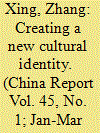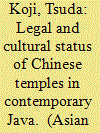| Srl | Item |
| 1 |
ID:
092418


|
|
|
|
|
| Publication |
2009.
|
| Summary/Abstract |
Already in the nineteenth century, the Chinese immigrants had built several Chinese temples in Kolkata. These temples, including those dedicated to Tianhou and Guanyin, served not only as religious shrines but also meeting places for the community. This article outlines some of the unique, and hitherto unexamined, religious practices among the Kolkata Chinese. Specifically, it focuses on the venerations of the Atchew, perceived to be the first Chinese immigrant in India, the medium known as Lady Shou and the Indian Goddess Kali. While other religious beliefs among the Kolkata Chinese indicate the preservation of Chinese heritage and identity, these unique practices show the process of acculturation and the creation of a new mixed,Chinese-Indian identity.
|
|
|
|
|
|
|
|
|
|
|
|
|
|
|
|
| 2 |
ID:
114683


|
|
|
|
|
| Publication |
2012.
|
| Summary/Abstract |
Since the collapse of Soeharto's New Order in 1998, Indonesia has been experiencing broad political and social changes. While the Soeharto regime was generally cautionary and oppressive toward anything related to China or the ethnic Chinese, the subsequent administrations faced the pressure to make sweeping changes to existing discriminatory policies and laws, and have put these changes into action, though gradually. With this major change in the social environment, an atmosphere is being engendered across the nation, producing a feeling that anyone is free to enjoy 'Chinese culture' which for a long time was banned from being expressed in public. This spirit is palpable for example during Chinese New Year, when red lanterns and other ornate decorations, and characters such as Gong Xi Fa Cai () are seen dancing about everywhere. Along with upscale malls and hotels, it is Chinese temples (klenteng) that have become the centers of these festivities. Having been the anchorage of traditional worship for the ethnic Chinese, during the Soeharto era these facilities were the target of unfavorable treatment. In the last few years, their activities have gradually been revitalized. This article scrutinizes the changed legal and cultural status of the Chinese temples engendering changes within the Chinese community at large, by focusing on developments in post-'New Order' Java.
|
|
|
|
|
|
|
|
|
|
|
|
|
|
|
|